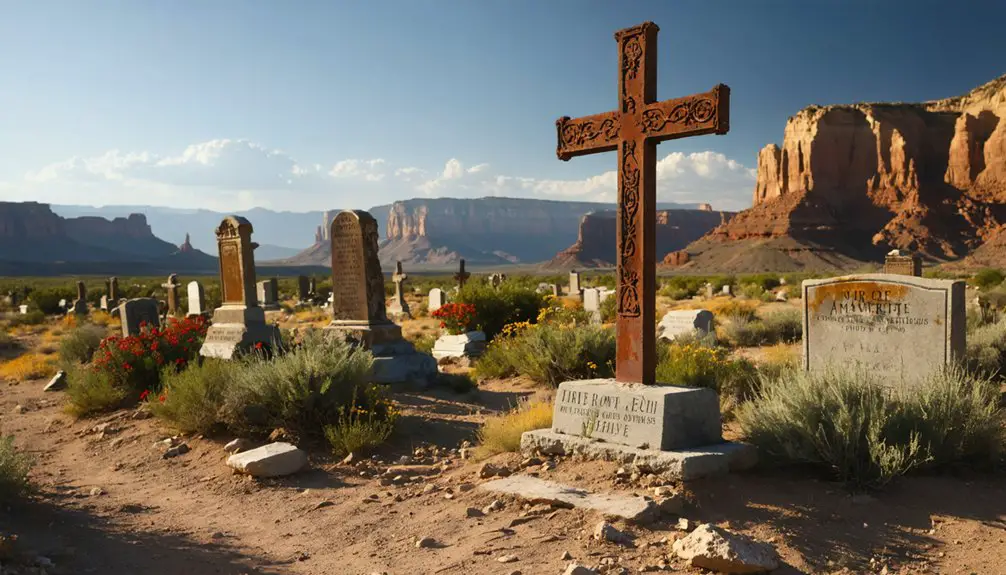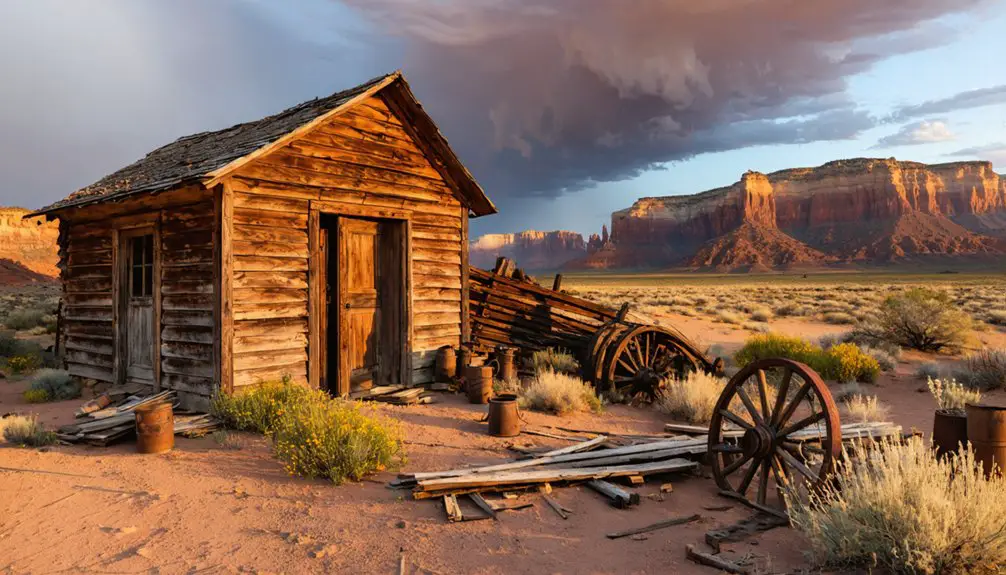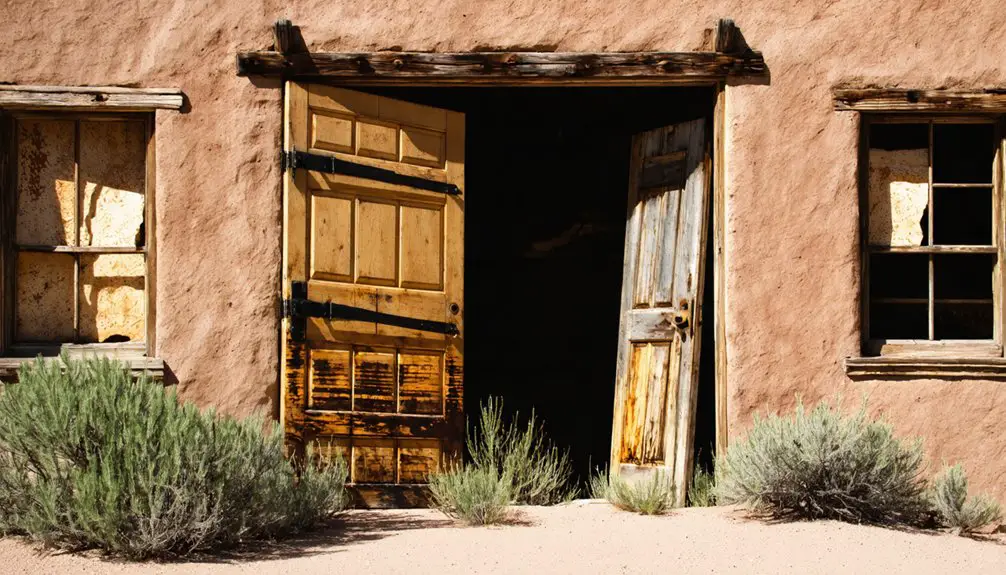You’ll find Upper Kanab’s ghost town ruins nestled in Utah’s dramatic desert landscape, where Mormon pioneers established a settlement in 1864. The site features scattered foundation remnants and weathered markers that tell tales of frontier families who battled flash floods, Navajo raids, and harsh conditions. While nature has reclaimed much of the area, you can still explore the historic cemetery, old field outlines, and infrastructure traces that showcase the settlement’s resilient spirit. The site’s connection to Hollywood’s golden age adds another fascinating layer to its rich heritage.
Key Takeaways
- Upper Kanab was initially settled by Mormon pioneers in 1864, with fort construction marking the beginning of the settlement.
- The original settlers abandoned the area by December 1865 due to conflicts with Navajo raiders before resettling in 1870.
- Today, the ghost town’s remains include scattered foundation remnants and deteriorated homestead ruins slowly disappearing into the desert.
- The site preserves the history of pioneers, gold miners, and frontier families who shaped the landscape from the 1860s-1900s.
- Access is via Highway 89 and a 5-mile dirt road, with best visiting conditions during spring and fall.
The Mormon Settlement Years
While Mormon pioneers had previously attempted to settle various parts of southern Utah, their efforts to establish Upper Kanab began in earnest with the construction of a fort in 1864-65.
You’ll find that colonial conflicts with Navajo raiders forced the initial settlers to abandon their foothold by December 1865, but they weren’t deterred for long.
After Brigham Young’s blessing in 1870, settlers surveyed town lots and established agricultural practices that would sustain their community.
With Young’s 1870 blessing, pioneers laid foundations in Kanab through careful planning and sustainable farming methods.
Jacob Hamblin successfully negotiated peace agreements with local Native American tribes, helping ensure the settlement’s survival.
The settlers established their community at an elevation of 5,000 feet, adapting to the semi-desert climate of the region.
They engineered wide streets flanked by irrigation ditches, built a schoolhouse, and organized a ward structure that became the backbone of their society.
The settlement quickly expanded along Kanab Creek, where you’d have seen determined pioneers transforming the landscape through cattle ranching and crop cultivation despite the challenging environment.
Life in Early Upper Kanab
After establishing permanent roots in Upper Kanab around 1865, Mormon settlers faced the delicate balance of building a thriving community while managing relationships with local Native American tribes.
You’d find these pioneers adapting to harsh desert conditions, developing innovative agricultural practices near the creek, and raising cattle as their economic backbone.
The community dynamics centered around their LDS faith, with families working together on farms and community projects. The Southern Paiute tribes had become the dominant indigenous group in the region before the settlers arrived.
You’ll notice their resourcefulness in building adobe homes and defensive fortifications, while creating wide, tree-lined streets that transformed the desert landscape.
They’ve established irrigation systems and wells, making the most of limited water resources.
Their determination paid off – by the 1870s, despite occasional evacuations and challenges, they’d created a stable settlement that would later become known for its progressive governance. The Deseret Telegraph line connected the remote settlement to the outside world in 1871.
Natural Disasters and Challenges
Flash floods repeatedly ravaged Upper Kanab’s early settlement, as the town’s position near Kanab Creek left it vulnerable to sudden water surges during intense storms.
You’ll find evidence of these devastating floods in the deeply incised channel of Kanab Creek, which has carved through layers of sediment since the 1880s. The creek’s unstable walls reach up to 60 feet in height, creating hazardous conditions for nearby areas.
The region’s mining operations struggled against nature’s fury, with seasonal downpours washing out access roads and flooding shafts, ultimately contributing to the town’s eventual abandonment. Similar to nearby Paria Ghost Town, poor dam construction and overgrazing accelerated the area’s decline.
Flash Flood Devastation Impact
Throughout its history, Upper Kanab’s location in a semi-arid region with steep washes and deeply incised channels has made it particularly vulnerable to devastating flash floods.
You’ll find that rainfall rates of up to 1.5 inches per storm have triggered dangerous water surges, overwhelming drainage systems and reshaping the landscape. The area’s flood preparedness challenges are magnified by the quick onset of these events, often leaving little time for response. The Little Hollywood Museum, a cherished historical site, has endured severe damage from four flooding events in just two years. Recent flooding has caused major damage to several homes in the community.
- Flash floods have destroyed up to 20 homes in single events, while inundating streets and damaging critical infrastructure.
- The 2005 landslide along Kanab Creek claimed a child’s life, highlighting the deadly combination of flooding and unstable terrain.
- Community resilience has been tested by recurring floods that bring massive boulders, debris, and sediment through the town’s narrow channels.
Mining Operations Weather Setbacks
Despite promising mineral deposits in the region, Upper Kanab’s mining operations endured persistent weather-related challenges that tested both human resilience and technological capabilities.
You’d have witnessed miners battling extreme weather impacts as they attempted to maintain their operations in the rugged terrain. Heavy snowfall and rainstorms frequently flooded underground tunnels, while harsh winds scattered ore stockpiles across the landscape.
The mining challenges weren’t limited to the elements alone – seasonal freeze-thaw cycles triggered dangerous rockfalls and tunnel collapses that threatened worker safety. Like many mining sites in the region, Upper Kanab’s struggles mirrored the difficulties faced at Capitol Reef Monument, where numerous operations failed to yield significant wealth.
A devastating flash flood in 1984 swept uranium ore into nearby Kanab Creek, causing environmental damage that was never properly remediated.
The crude access roads you’d need to reach these remote sites often became impassable during storms, disrupting essential supply lines and worker transportation.
These weather setbacks constantly hampered the mining community’s efforts to establish lasting operations.
Hollywood’s Desert Backdrop
Since its debut as a filming location in 1924 with “The Deadwood Coach,” Kanab’s striking red rock desert landscapes have drawn Hollywood’s attention, earning the region its “Little Hollywood” nickname.
You’ll find this cinematic heritage deeply embedded in Upper Kanab’s surroundings, where film history comes alive through preserved movie sets and natural backdrops that have hosted over 100 productions.
The Johnson Canyon set, built in 1951, still stands as a monument to the area’s golden age of Western filmmaking.
- Trek through the same rugged terrain where John Wayne and Clint Eastwood once rode
- Explore the original Homestead set at Little Hollywood Movie Museum, featured in “The Outlaw Josey Wales”
- Visit iconic locations used in classics like “Gunsmoke,” “The Lone Ranger,” and “Planet of the Apes”
The Cemetery’s Silent Stories

Hidden among the desert cottonwoods and sandy paths of Upper Kanab lies the Paria Cemetery, where roughly 20 graves tell the poignant stories of the region’s early settlers.
As you walk among the weathered markers, you’ll encounter silent narratives of Mormon pioneers, gold miners, and frontier families who braved the harsh desert conditions of the 1860s through early 1900s.
The historical echoes of their struggles against frequent flooding, disease, and isolation resonate through the replacement headstones that now stand where wooden markers once existed.
While vandalism and erosion have taken their toll, this fragile historic site serves as one of the last tangible connections to Upper Kanab’s past, preserving the memory of those who shaped this rugged landscape.
Geological Wonders and Formations
A geological wonderland surrounds Upper Kanab, where seventeen distinct rock formations span the Permian through Tertiary periods.
You’ll find yourself standing amid towering sedimentary layers that tell Earth’s ancient stories, from the Jurassic Moenave Formation to the marine-rich Tropic Shale. The landscape’s dramatic geological formations showcase nature’s raw power, with the Shinarump Conglomerate forming resistant ledges and the iconic Chocolate Cliffs step of the Grand Staircase.
- The Tropic Shale contains marine fossils dating back to the Cenomanian and Turonian stages, revealing an ancient seabed.
- You can spot petrified wood fragments and distinctive limonite bands in the Shinarump’s coarse-grained sandstone.
- Fault zones like Sevier and Kanab Creek have shaped the terrain, leaving visible evidence of tectonic forces.
These geological features stand as untamed monuments to time’s passage, inviting exploration of their rugged beauty.
What Remains Today

Modern visitors to Upper Kanab encounter a landscape where nature has largely reclaimed the ghost town‘s former footprint.
You’ll find scattered foundation remnants and deteriorated homestead ruins slowly disappearing into the desert terrain, while the surrounding cliffs and rock formations dominate the vista.
The most significant historical artifacts remain at the Old Paria cemetery, where weathered gravestones and memorial plaques tell stories of early settlers.
While archaeological findings are limited, you can still trace old field outlines and catch glimpses of former infrastructure like wells and road traces.
Faint outlines in the desert soil reveal lost fields and pathways, whispering stories of those who worked this land before.
Informational kiosks and interpretive signs help you visualize the settlement’s past glory, making up for the absence of standing structures.
The Paria River continues to shape the landscape, just as it did when pioneers first settled here.
Planning Your Visit
You’ll want to visit Upper Kanab ghost town during the “golden hour” of early morning or late afternoon for the best photographic conditions and most vivid views of the surrounding landscape.
To reach the site, take Highway 89 about 35 miles east of Kanab city, then turn onto a 5-mile dirt road that leads to the ghost town’s parking area and information kiosks.
While the site is accessible year-round, you should check weather forecasts before visiting since rain can make the dirt road impassable, particularly in sections with deep washes where high-clearance vehicles are recommended.
Best Time to Visit
Planning the perfect time to explore Upper Kanab’s ghost town requires careful consideration of both seasonal conditions and visitor patterns. Spring and fall offer the most comfortable temperatures for exploring, with mild weather in the 60s to 70s°F and stable trail conditions.
You’ll find fewer crowds during weekdays and off-season months, allowing for a more intimate experience with this historic site.
- Spring visits (March-May) provide ideal photography conditions with wildflowers and dramatic cloud formations.
- Early morning or late afternoon exploration maximizes golden hour lighting for capturing the ghost town’s weathered textures.
- Fall months (September-November) combine pleasant temperatures with reduced tourist traffic, perfect for unrushed exploration.
Your best visitor experience will come from timing your visit during shoulder seasons, avoiding summer’s intense heat and winter’s potential trail hazards.
Getting There Safely
While reaching Upper Kanab ghost town requires careful preparation, the journey through Utah’s rugged backcountry offers a memorable adventure for well-equipped visitors.
You’ll find the site via Paria River Valley Road off US 89, about 37 miles east of Kanab or 39 miles northwest of Page, Arizona.
Road conditions demand a high-clearance vehicle, preferably with 4WD, as the unpaved 4.7-mile access road can become treacherous when wet.
Essential travel tips include checking weather forecasts before departure, carrying emergency supplies, and bringing a reliable GPS.
You’ll need extra water, a spare tire, and fully charged phones, though don’t count on cell service.
Remember to share your travel plans with someone reliable, as this remote location within Grand Staircase-Escalante National Monument requires self-sufficiency.
Photography and Scenic Spots

Several remarkable photographic destinations surround the ghost town of Upper Kanab, with the Old Paria ruins and nearby slot canyons offering diverse shooting opportunities.
You’ll find dramatic lighting conditions in Peekaboo Canyon’s narrow passages, where photographic techniques like long exposures capture stunning midday light beams.
White Pocket’s swirling formations come alive during golden hours, while the Belly of the Dragon’s unique cave formations provide compelling compositions.
- Slot canyons demand wide-angle lenses and tripods for low-light conditions, especially during prime morning hours
- After rainfall, White Pocket’s colorful rock pools create mirror-like reflections perfect for abstract compositions
- Strategic timing at Old Paria ruins allows you to capture the layered geological story against dramatic desert skies
Preservation Efforts and Legacy
Beyond the dramatic landscapes that draw photographers, Upper Kanab’s rich heritage remains a focal point of regional preservation efforts.
You’ll find ghost town preservation initiatives that complement Kanab city’s broader commitment to protecting pioneer history and natural scenery. Heritage conservation extends throughout the area, with downtown storyboards and interpretive signage helping you connect with the region’s past.
While specific Upper Kanab sites face private ownership challenges, you’re seeing increasing collaboration between property owners and local preservation groups.
The city’s emphasis on maintaining historic buildings, agricultural heritage, and walking paths makes it easier for you to explore these cultural treasures.
Through carefully planned restoration projects and community engagement, Upper Kanab’s legacy continues to shape the region’s historical narrative and cultural identity.
Frequently Asked Questions
Are There Any Dangerous Wildlife Encounters Reported in the Upper Kanab Area?
Mother Nature’s wild friends keep their distance, but you’ll want to maintain wildlife safety since mountain lions, bobcats, and rattlesnakes frequent the area, though no specific dangerous animal sightings are documented here.
What Indigenous Artifacts Have Been Discovered Around the Upper Kanab Settlement?
You’ll find indigenous pottery sherds scattered on slopes and ridge tops, plus ancient tools like stone flakes in erosion channels. Virgin Anasazi left dwelling remnants with postholes and charred wood dating post-1200 A.D.
Can Visitors Stay Overnight in the Remaining Structures of Upper Kanab?
Despite 100+ annual requests, you can’t stay overnight in these historic structures. Local ordinances prohibit lodging due to structure safety concerns, but you’ll find comfortable accommodations minutes away in Kanab.
Were Any Notable Outlaws or Criminals Known to Hide in Upper Kanab?
You’ll find Nate Hansen’s outlaw legends tied to Upper Kanab, where he met his end after stealing cattle. While criminal hideouts existed in nearby canyons, no other famous outlaws permanently settled here.
Does Upper Kanab Experience Extreme Temperature Variations Throughout the Year?
Under vast desert skies, you’ll experience dramatic temperature swings. The seasonal changes sweep from winter’s frigid 24°F nights to summer’s scorching 92°F days, with temperature records showing daily fluctuations exceeding 40°F.
References
- https://www.musthikemusteat.com/beyond-the-pnw/paria-pahreah-ghost-town-cemetery/
- https://en.wikipedia.org/wiki/Paria
- https://roadtrippers.com/magazine/kanab-utah-little-hollywood/
- https://livethatadventure.com/paria-townsite-and-ruins-a-beautiful-addition-to-your-utah-road-trip/
- https://www.americansouthwest.net/utah/grand_staircase_escalante/paria.html
- https://www.uen.org/utah_history_encyclopedia/k/KANAB.shtml
- https://www.nps.gov/parkhistory/online_books/pisp/adhi/adhi1h.htm
- https://npshistory.com/publications/pisp/adhi/chap1.htm
- https://archiveswest.orbiscascade.org/ark:80444/xv44747
- https://www.visitsouthernutah.com/blog/the-explorer-destination-150-years-of-exploration-and-discovery-in-kanab/



